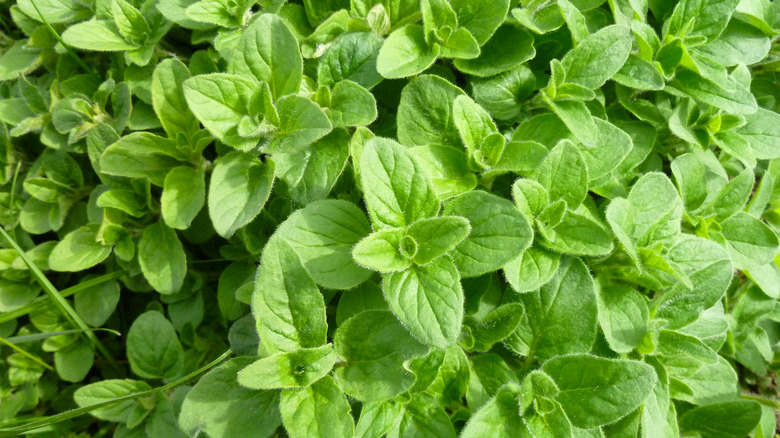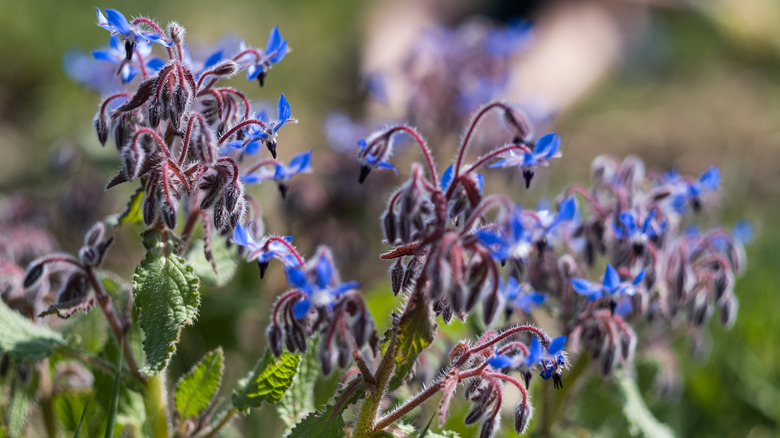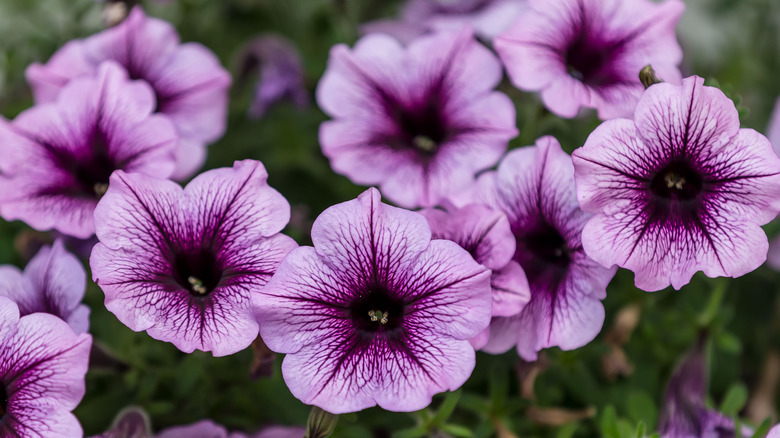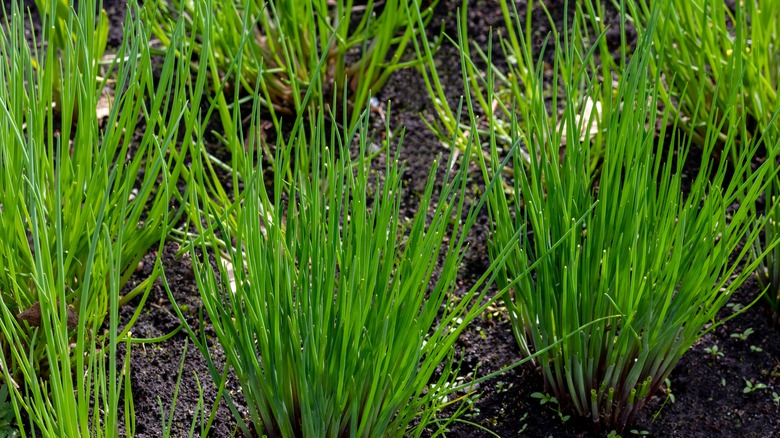Companion Plants That Will Be A Pumpkin's Best Friend
Pumpkins (Cucurbita pepo) are an iconic fall vegetable that many love to include in their home gardens. Often, this type of gourd proves to be fairly simple to grow and very rewarding when it's time to harvest your pumpkins. With just a bit of regular maintenance, pumpkin plants bloom in the summer as they are provided with direct sunlight, moist but well-draining soil, and lots of space to grow. However, they have the ability to grow even larger and produce more when planted with the right companions.
Companion planting methods have been used for ages to make the most out of vegetable, flower, and herb gardens. Pumpkins can be an important part of this, but it all depends on the types of crops you're growing. In general, pumpkins won't grow well with broccoli, cauliflower, kohlrabi, other members of the cabbage family, and potatoes. Yet, there are dozens of other vegetables and herbs that can benefit your pumpkins simply by growing nearby. Keep reading to learn about some of our favorite options.
1. Tansy
Tansy (Tanacetum vulgare) is a weedy perennial in the daisy family. Though it can be a difficult herb to control, it isn't all bad. The leaves and flowers' pungent fragrance helps scare away a few common garden pests. Specifically, tansy repels Japanese beetles, which are known to eat their leaves and fruits. As a bonus, the herb is also reported to increase the potassium present in the soil.
Bloom Season: Summer
USDA Growing Zone: 3 to 8
Growing Conditions: Full sun to partial shade
Soil Type: Moist, humusy, and well-draining
Size: 1 to 3 feet tall and wide
2. Radishes
You might consider planting radishes (Raphanus sativus) next to your pumpkins if you aren't a huge fan of the red vegetable's taste. The root vegetables are known to be very attractive to flea beetles, which also pester potatoes, sunflowers, squash, and more. By growing radishes near pumpkins and other crops that flea beetles often snack on, you can trick the pests into eating the radishes instead of your more valuable veggies.
Bloom Season: Spring
USDA Growing Zone: 2 to 11
Growing Conditions: Full sun
Soil Type: Well-draining loam or sand
Size: 2 to 3 feet tall
3. Pole beans
You might already know that pole beans (Phaseolus coccineus) can either be the best or worst thing for your garden depending on what you're growing. When planting pumpkins and corn for your fall harvest, consider adding pole beans to complete the "Three Sisters" method. The beans fix the nitrogen in the soil while corn plants provide a natural trellis. On the ground, the pumpkins offer a living mulch-like effect in return.
Bloom Season: Summer to fall
USDA Growing Zone: 7 to 11
Growing Conditions: Full sun
Soil Type: Moist and well-draining
Size: 8 to 13 feet tall
4. German chamomile
The annual flower, German chamomile (Matricaria recutita), is a short-growing member of the daisy family, which is obvious from its blooms. The plant produces fragrant beetle-repelling flowers with small white petals and a yellow center. Grown next to a pumpkin plant, German chamomile will quickly adapt to the cucurbits' preferred growing conditions, including growing in moist and well-draining soil.
Bloom Season: Summer
USDA Growing Zone: 2 to 8
Growing Conditions: Full sun
Soil Type: Well-draining
Size: 12 to 24 inches tall and 9 to 12 inches wide
5. Marigolds
Growing multi-faceted garden flowers like French marigolds (Tagetes patula) in your garden can have more benefits than you think. The marigolds' petals in shades of red and yellow are scented to keep pests like nematodes away from your pumpkins, while also enticing bees and butterflies to come and pollinate them.
Bloom Season: Spring to fall
USDA Growing Zone: 2 to 11
Growing Conditions: Full sun to partial shade
Soil Type: Moist and well-draining
Size: 1 foot tall and wide
6. Oregano
Oregano (Origanum vulgare) can be a valuable asset in your vegetable garden this summer and fall. Not only does it have uses in the kitchen, creating delicious pasta, homemade pizza, and seasoned meat dishes, but it also helps the other plants grow properly as it wards off harmful insects. By planting small sections of oregano in between your squash and pumpkins, you can finish out fall with a high yield of produce.
Bloom Season: Summer
USDA Growing Zone: 3 to 9
Growing Conditions: Full to partial sun
Soil Type: Well-draining
Size: 2 feet tall and wide
7. Borage
The borage plant (Borago officinalis) is an herb that is grown for its edible leaves and flowers, as well as its ornamental blue star-shaped blooms. There are a few reasons why it is such a good friend to pumpkin plants, in particular, as it easily attracts pollinator species and is thought to help pumpkins grow faster and more healthily when placed nearby.
Bloom Season: Spring and summer
USDA Growing Zone: 6 to 9
Growing Conditions: Full sun to partial shade
Soil Type: Well-draining and sandy
Size: 3 feet tall
8. Sunflowers
Sunflowers (Helianthus annuus) are another good pollinator-attracting flower to grow next to pumpkins. One of the best things about them is their towering height, which brings bees, birds, and butterflies to your garden from far and wide. Not only will this help you enjoy a larger harvest from your garden, but it will also make healthier pumpkins, as several of their worst pests are dealt with by the beneficial insects sunflowers attract.
Bloom Season: Summer to fall
USDA Growing Zone: 2 to 11
Growing Conditions: Full sun
Soil Type: Rich, loose, and well-draining
Size: 5 to 10 feet tall
9. Catnip
Catnip plants (Nepeta cataria) have many uses in the garden. Their leaves can be harvested to make a soothing tea, dried out and given to cats, or grown in the garden to deter pests from eating your vegetables. Catnip can be especially valuable when you plant it with crops that are targeted by flea beetles, like pumpkins, as their scent is repulsive to these pests and others.
Bloom Season: Spring
USDA Growing Zone: 3 to 7
Growing Conditions: Full sun
Soil Type: Well-draining
Size: 2 to 3 feet tall and wide
10. Nasturtiums
Nasturtium (Tropaeolum spp.) is a gorgeous flower that's often planted in hanging baskets, window planters, and even in vegetable gardens. The versatile and long-blooming plant is worth more than its looks, however. Nasturtium flowers are frequently planted to repel pests such as pumpkin and squash beetles, which is why it is such a good companion plant to Cucurbita species.
Bloom Season: Spring to fall
USDA Growing Zone: 2 to 11
Growing Conditions: Full sun
Soil Type: Well-draining
Size: 1 to 10 feet tall and 1 to 3 feet wide
11. Marjoram
Marjoram (Origanum majorana), an herb that is frequently used in Mediterranean dishes, can be a good neighbor to pumpkin plants. We know for certain that its fragrant foliage deters a few common garden pests from eating your precious harvest, however, it might be useful for another reason. Some believe that marjoram planted next to pumpkins and other vegetables will improve their flavor.
Bloom Season: Summer
USDA Growing Zone: 9 to 11
Growing Conditions: Full sun
Soil Type: Gritty or sandy and well-draining
Size: 1 to 2 feet tall and wide
12. Petunias
Petunias (Petunia spp.) might be one of the best flowers to pair with your pumpkins if you are trying to keep pests away from them naturally. Not only do they keep away squash bugs with the scent of their blooms, but they also add ornamental flair to your vegetable garden. Unlike French marigolds, pot marigolds, and nasturtium, however, their flowers come in a wide variety of colors for you to choose from.
Bloom Season: Spring
USDA Growing Zone: 10 to 11
Growing Conditions: Full sun
Soil Type: Rich and well-draining
Size: 6 to 15 inches tall
13. Chives
Known for their fragrant grass-like leaves, chives (Allium schoenoprasum) are great herbs to deter hungry pests and to use as a garnish in your garden-fresh meals this summer and fall. The foliage is known to smell like onions, which is upsetting for the bugs, but so delicious in soups, salads, and other dishes. Planting them near your pumpkins allows you to achieve a spectacular harvest.
Bloom Season: Summer
USDA Growing Zone: 4 to 8
Growing Conditions: Full sun to partial shade
Soil Type: Moist and well-draining
Size: 4 to 20 inches tall
14. Basil
The basil plant (Ocimum basilicum), like catnip, is a useful flea beetle repellent in vegetable gardens. Its foliage and flowers are delightfully scented to us humans, but exactly the opposite for many harmful insects. Thankfully, basil also has very similar growing requirements to pumpkins. Both plants will grow in well-draining soil that receives consistent direct sunlight and regular watering to keep their roots hydrated.
Bloom Season: Summer to fall
USDA Growing Zone: 2 to 11
Growing Conditions: Full sun
Soil Type: Rich, moist, and well-draining
Size: Up to 2 feet tall and wide
15. Clover
Similarly to pole beans, white clover (Trifoleum repens) planted near pumpkins can fix the nitrogen in the soil they're growing in. Balanced nitrogen helps pumpkins and other vegetable plants produce even more crops as they grow larger and healthier. Another thing that aids in a healthy harvest is pollinators, which white clover can also help with. During its bloom time, clover attracts butterflies and honey bees.
Bloom Season: Spring and summer
USDA Growing Zone: 3 to 10
Growing Conditions: Full sun to partial shade
Soil Type: Moist and well-draining
Size: 6 inches tall and 1 foot wide
16. Melon
Melons (Cucumis melo) grow well with pumpkins because they share nearly all the same growing requirements. Both plants enjoy direct sunlight, plenty of space to grow, warm temperatures, and moist and well-draining soil. Each of them is also fairly easy to maintain, and they produce large fruits in the fall.
Bloom Season: Summer
USDA Growing Zone: 2 to 11
Growing Conditions: Full sun
Soil Type: Loose, moist, rich, and well-draining
Size: 6 to 9 feet tall and 1 to 3 feet wide
17. Scorpion weed
Scorpion weed (Phacelia tanacetifolia) is a wonderful flower to plant next to almost any vegetable. It is particularly helpful for growing nearby crops such as pumpkins, melons, zucchini, and other cucurbits that need assistance in attracting pollinators to their blooms. This relatively tall-growing flower brings in hoards of bees, butterflies, and other beneficial insects.
Bloom Season: Spring and summer
USDA Growing Zone: 2 to 10
Growing Conditions: Full sun
Soil Type: Gritty and well-draining
Size: 1 to 3 feet tall and wide
18. Calendula
Calendula (Calendula officinalis), also known as the pot marigold, is an easy-to-grow flower that resembles French marigolds. Like French marigolds, the calendula flower is also edible and quite fragrant. Because of its scent, it is effective at deterring insects such as beetles and nematodes from entering your garden to eat the crop plants that you've worked so hard to raise.
Bloom Season: Spring to fall
USDA Growing Zone: 2 to 11
Growing Conditions: Full sun to partial shade
Soil Type: Moist and well-draining
Size: 1 to 2 feet tall and wide
19. Dill
Dill plants (Anethum graveolens) are more versatile than they seem. They are a tasty herb, an ornamental plant, a beacon for attracting pollinators, an effective pest repellent, and even an important ingredient in some spells and natural medicines. Specifically, dill plants ward off cabbage worms, which are known for raising their young on the pumpkins' large leaves.
Bloom Season: Summer
USDA Growing Zone: 2 to 11
Growing Conditions: Full sun
Soil Type: Rich and well-draining
Size: 18 inches to 4 feet tall



















